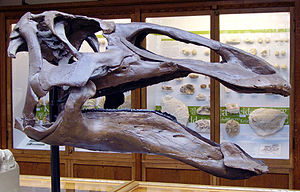Praedentale
|
|
|
|---|---|
| A side view of an Edmontosaurus skull : in front of the tooth-bearing lower jawbone (dental) sits the shovel-shaped predental (see red marking). |
The praedentale is an additional bone at the anterior (rostral, symphysial ) end of the lower jaw that is exclusively found in bird's pelvis dinosaurs (Ornithischia) . It thus represents an autapomorphic feature of the ornithic animals and belongs to the most important diagnostic features of this group in addition to the characteristic twin- beam pelvic shape . In the original ( plesiomorphic ) state, the tooth-bearing bone, the dental , forms the front end of the lower jaw in dinosaurs (and in vertebrates in general). The term predentary ( lat . Prae- = forward, ') refers to the fact that this bone is at the tip of the lower jaw before the Dental.
The Praedentale is an unpaired, often shovel-shaped bone, the exact shape of which varies in the individual groups. The Hadrosauridae are wide and round, whereas the Ceratopsia are narrow and pointed. It never bears teeth and is the functional counterpart of the intermaxillary bone (premaxillary) of the upper jaw , which is also mostly toothless in ornithischians (only in Ceratopsia the rostral bone forms the counterpart of the predental instead of the premaxillary ). Together with this it forms the beak-like tip of the snout, which is typical of the herbivorous ornithischier, which is clad with horn sheaths in living animals, and which was used to pluck the vegetation.
literature
- David Fastovsky , David Weishampel : The Evolution and Extinction of the Dinosaurs . Cambridge University Press, 2005, ISBN 0-521-81172-4 .
- Wilfried Westheide , Reinhard Rieger (Hrsg.): Special zoology. Part 2: vertebrates or skulls . Spektrum Akademischer Verlag, Heidelberg / Berlin 2004, ISBN 3-8274-0307-3 , pp. 401-402.

